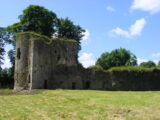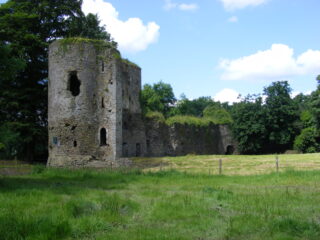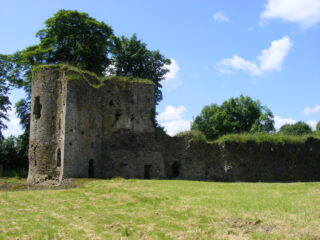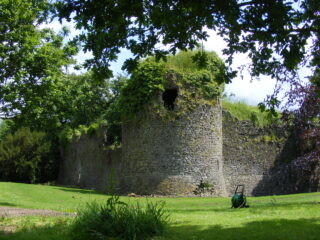Notice
Kilbolane Castle is a state-owned National Monument in the care of the Office of Public Works
*Public Access is Not Permitted to Kilbolane Castle*
WARNING: It should be noted that these sites are unguided and a level of care and caution should be maintained during all stages of your visit. The Office Of Public Works (OPW) will not be held responsible for any damages, injuries, or losses that occur
Kilbolane Castle
Sitting on top of Kilbolane hill is Kilbolane Castle, less than 1km from Milford village. Kilbolane is an example of an enclosure castle; originally similar in style to the still standing Liscarroll Castle. Kilbolane dates to the 13th century, when it was founded by Maurice de Rocheford, a Norman Knight, and forms part of a line of castles, including Liscarroll Castle, built to defend Norman territory from attacks by resurgent Gaelic clans. The ruins of Kilbolane is that of two circular defence towers and a curtain wall.
By the 14th century Thomas mac Shane Fitzgibbon was noted as the owner and his descendants held it until 1587 when it was granted to Hugh Cuffe. But it was during the Fitzgibbon tenure that the castle was extensively renovated, with curtain walls being rebuilt and a new vaulted ceiling inserted into the towers. Cuffe, an English born merchant and soldier, benefitted from the failed Desmond Rebellion and the following Munster Plantation as he was granted Kilbolane Castle. However, the Fitzgibbons retook the castle. During the Desmond rebellion, David Fitzgibbon lost his vast estates including Kilbolane. However David had surrendered to the Earl of Ormonde and thus should not have had his lands confiscated. David’s kinswoman, Ellen Gibbon, knew about this mistake and applied that these estates be handed back in a suit noted December 1589 to Queen Elizabeth I. In 1591 Queen Elizabeth I ordered Hugh Cuffe to surrender the lands of Kilbolane to Ellen and her husband William Power of Waterford.
In 1592, William wrote to Lord Burghley complaining that his wife Ellen had undone much of Cuffe’s renovations, while Cuffe was himself claiming compensation for the cost of his renovations. Cuffe lost 6,000 acres after it was re-granted to Ellen and William. Peace was not to be however. In another rebellion in Munster in 1598 William lost Kilbolane Castle to Captain Tyrrell, who was gifted Kilbolane by the Earl of Desmond.
William went on to have a most eventful life thereafter, in the company of Earl of Ormond, Earl of Essex who gave William command of the biggest army Ireland had seen, until Lord Deputy discharged him in 1600, only to be reinstated after complaining to Cecil in London. William was involved when the George Carew Lord President of Munster was trying the catch the Súgán Earl to such an extent that William was part of a rouse to ambush the Súgán Earl. In 1602 William was with Sir Samuel Bagnall at Macroom. In 1610 William was knighted and in 1615 was allowed to surrender his lands for them to be re-granted back to him, including Kilbolane. William’s son and heir John predeceased him but left issue David. In 1641 and in 1642 William and his grandson are noted for mischief in the Liscarroll area. William still lived at Kilbolane Castle. As a result of David’s actions he was sent by Cromwell’s men to Connaught and lost 7,000 acres in Cork including the Castle. However in 1666 David was restored to 1,000 acres by the court of claims, but not Kilbolane.
In 1654 Kilbolane Castle was granted to Captain John Nicholls, of Lord Broghill’s regiment under the command of Cromwell. Nicholls built up a large estate around Kilbolane but had no son to inherit it. Nicholls daughter Mary was to marry John Bowen and a deal was made in 1659 that should they make Kilbolane Castle their home, Nicholls would leave his entire estate to Bowen. Mary and John Bowen and their subsequent family were the owners of Kilbolane and eventually built Kilbolane house in the 18th century. John Bowen was the eldest son of Lt. Col. Henry Bowen of Farrahy, near Doneraile in North Cork, whose own homestead Bowenscourt was inherited by the famous Irish writer and socialite Elizabeth Bowen.
The west tower’s entrance is at ground level on the east side, with a round masonry arch over the doorway. Entry into a circular ground floor is lit by two slit windows to the north and south-west. At the south side of the ground chamber a curving mural stairs leads up to the first floor.
The first floor chamber is hexagonal with a pointed vault ceiling, lit by windows on the west and south-west sides. The windows both have splayed embrasures and roofed segmental vaults but the south-west window has a window seat and ogee-headed light. Only a stump of the tower survives at the second floor.
The south tower’s entrance is at ground level on the north side. The round headed door was rebuilt in the 17th century possibly by Cuff, then Ellen. A possible murder hole is overhead and a circular ground floor is then entered. Window slits are found on the south and south-west wall with the embrasure roofed by flat vaults with the south-west window also having a gun loop. A spiral stone saris gives access to the first floor.
The first floor chamber of this south tower has a pointed domed vault and windows to the north-west and south wall. The north-west window has a window seat while the south window has an ogee-headed light. Architectural features here include a drawbar and hanging eye socket for a door and a pointed door arch. A narrow stairs becomes a spiral stone stair giving access to the second floor, of which there is none, lost to decay and time.
A curtain wall to the south-west and another curtain wall to the north-west survive but are ruinous. The north curtain wall has a door inserted, possibly from when Kilbolane house was built against it. Part of a moat also survives.
Visit Historic Environment Viewer for more information on Kilbolane Castle
Protect our Past - Click here to read about the importance of protecting our country’s unique heritage sites
This national monument is protected in accordance with the National Monuments Acts 1930 to 2014
Gallery
Nearby sites to visit
Desmond Castle Newcastlewest
Where sounds of medieval revelry echo around the walls
Approx. 19.2 km from Kilbolane Castle
Doneraile Court and Estate
North Cork’s ‘real-life Downton Abbey’
Approx. 22.5 km from Kilbolane Castle
Adare Castle
Discover a medieval masterpiece, built for defence
Approx. 25.5 km from Kilbolane Castle




